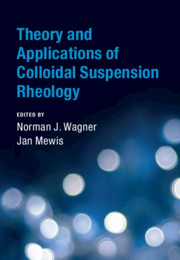Book contents
- Theory and Applications of Colloidal Suspension Rheology
- Cambridge Series in Chemical Engineering
- Theory and Applications of Colloidal Suspension Rheology
- Copyright page
- Dedication
- Contents
- Contributors
- Preface
- General List of Symbols
- Useful Physical Constants and Values
- 1 Introduction to Colloidal Suspension Rheology
- 2 Theory of Colloidal Suspension Structure, Dynamics, and Rheology
- 3 Methods of Colloidal Simulation
- 4 Microstructure under Flow
- 5 Rheology of Colloidal Glasses and Gels
- 6 Suspensions of Soft Colloidal Particles
- 7 Biocolloid Rheology
- 8 Hemorheology
- 9 Applications
- Index
- References
4 - Microstructure under Flow
Published online by Cambridge University Press: 07 April 2021
- Theory and Applications of Colloidal Suspension Rheology
- Cambridge Series in Chemical Engineering
- Theory and Applications of Colloidal Suspension Rheology
- Copyright page
- Dedication
- Contents
- Contributors
- Preface
- General List of Symbols
- Useful Physical Constants and Values
- 1 Introduction to Colloidal Suspension Rheology
- 2 Theory of Colloidal Suspension Structure, Dynamics, and Rheology
- 3 Methods of Colloidal Simulation
- 4 Microstructure under Flow
- 5 Rheology of Colloidal Glasses and Gels
- 6 Suspensions of Soft Colloidal Particles
- 7 Biocolloid Rheology
- 8 Hemorheology
- 9 Applications
- Index
- References
Summary
The microstructure of colloidal suspensions, both at rest and under flow, is a function of the particle and fluid properties, interparticle potential, and processing or flow history. Indeed, complex, nonlinear rheological phenomena, such as thixotropy and shear thickening, are associated with significant changes in microstructure during flow and processing. A modern understanding of colloidal suspension rheology thus necessitates measurement of colloidal suspension microstructure under flow as well as at rest. Two popular classes of experimental methods for microstructure measurement are introduced and explained, namely confocal microscopy and scattering of light, neutrons, and x-rays.
Keywords
- Type
- Chapter
- Information
- Theory and Applications of Colloidal Suspension Rheology , pp. 155 - 172Publisher: Cambridge University PressPrint publication year: 2021
References
- 2
- Cited by

